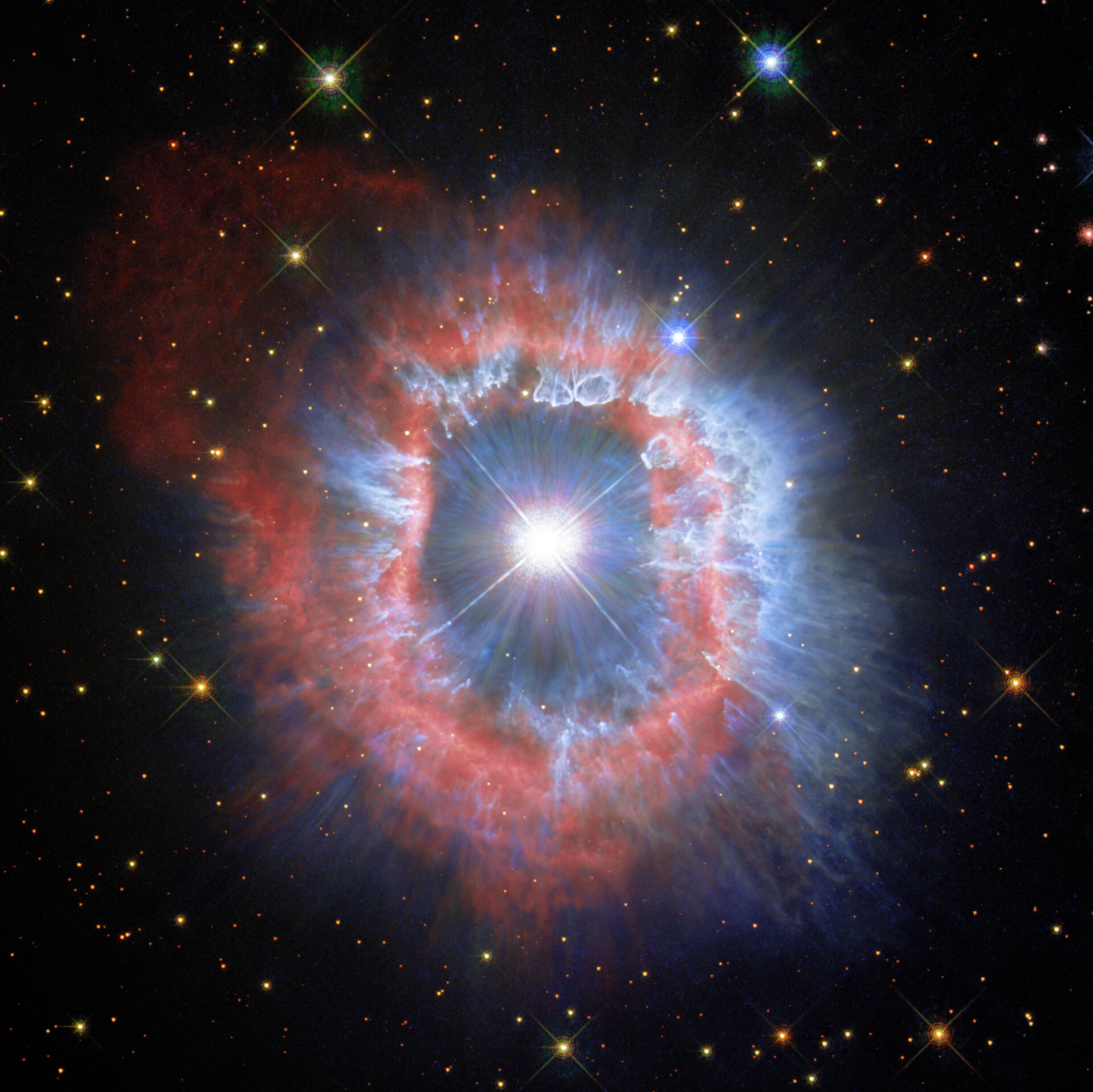Credits: ESA/Hubble and NASA, A. Nota, C. Britt
This comparison of two images shows puffing dust bubbles and an erupting gas shell – the final acts of a monster star’s life.
这两张图片的对比显示了膨胀的尘埃气泡和喷发的气体外壳——这是一颗巨型恒星生命的最后一幕。
These new views showcase the dual nature of the star AG Carinae, which was the target of the NASA/ESA Hubble Space Telescope’s 31st anniversary image in April 2021. This new perspective is the result of Hubble’s observations of the star in 2020 and 2014, along with others captured by the telescope’s Wide Field Planetary Camera 2 in 1994.
这些新图像展示了船底座AG这颗恒星的双重性质双重性质,这是NASA/ESA哈勃太空望远镜在2021年4月拍摄的31周年纪念照片的目标。这一新的视角是哈勃望远镜在2020年和2014年对这颗恒星进行观测的结果,以及1994年由该望远镜的广角行星照相机2拍摄的其他照片。
The first image showcases details of ionized hydrogen and nitrogen emissions from the expanding shell of the nebula (seen here in red). In the second image, the color blue delineates the distribution of dust that shines in reflected star light. Astronomers think powerful stellar winds coming off of the star formed and shaped the dust bubbles and filaments. The nebula is about five light-years wide, similar to the distance from here to the nearest star beyond the Sun, Proxima Centauri.
第一张图片展示了星云膨胀壳(红色部分)释放的电离氢和氮的细节。在第二幅图中,蓝色描绘了在反射星光中闪耀的尘埃分布。天文学家认为,来自恒星的强大恒星风形成并塑造了这些尘埃气泡和细丝。这个星云大约有5光年宽,相当于从这里到离太阳最近的恒星——半人马座比邻星的距离。
AG Carinae is formally classified as a Luminous Blue Variable because it is a hot (emitting blue light), brilliant star that varies in brightness. Such stars are quite rare because few are so massive. Luminous Blue Variable stars continuously lose mass in the final stages of life. The star is waging a tug-of-war between gravity and radiation pressure to avoid self-destruction. As the star begins to run out of fuel, its radiation pressure decreases, and gravity begins to take hold. Stellar material succumbs to gravity and falls inward. It heats up and is explosively ejected into the surrounding interstellar space. This process continues until enough mass is lost and the star reaches a stable state.
船底座AG被正式归类为蓝色发光变星,因为它是一颗热的(发出蓝光),明亮的恒星,亮度不一。这样的恒星是相当罕见的,因为很少有如此大质量的恒星。蓝色发光变星在生命的最后阶段不断失去质量。恒星在引力和辐射压力之间展开了一场拉锯战,以避免自我毁灭。当恒星开始耗尽燃料时,它的辐射压力就会减少,而引力开始占据主导地位。恒星物质屈服于引力,向内坠落。它发热并被爆炸性地喷射到周围的星际空间。这个过程一直持续到失去足够的质量,恒星达到一个稳定的状态。
The spectacular nebula surrounding AG Carinae formed by material ejected from the star during several of its past outbursts. The nebula is approximately 10,000 years old, and the observed velocity of the gas is approximately 43 miles per second. While this nebula looks like a ring, it is in fact a hollow shell whose center was cleared of gas and dust by a powerful stellar wind travelling roughly 124 miles per second. The gas (composed mostly of ionized hydrogen and nitrogen) in these images appears as a thick bright red ring, which appears doubled in places – possibly the result of several outbursts colliding into each other. The dust, seen here in blue, formed in clumps, bubbles, and filaments and was shaped by the stellar wind.
船底座AG周围壮观的星云,是由该恒星在过去的几次爆发中喷出的物质形成的。这个星云大约有1万年的历史,观测到的气体速度约为每秒43英里。虽然这个星云看起来像一个环,但实际上它是一个中空的壳,它的中心被一股强劲的恒星风以每秒124英里的速度吹走了气体和尘埃。在这些图像中,气体(主要由电离氢和氮组成)看起来像一个厚厚的明亮的红色环,在某些地方看起来加倍——可能是几次爆发相互碰撞的结果。图中蓝色尘埃是以团块、气泡和细丝的形式形成的,并被恒星风所塑造。
Scientists who observed the star and its surrounding nebula note that the ring is not perfectly spherical. It appears to have bipolar symmetry. This could mean the mechanism producing the outburst may be the result of a disk in the center, or the star may have a companion (known as a binary star). An alternative and simpler theory is that, like many massive stars, AG Carinae may rotate very fast.
观察这颗恒星及其周围星云的科学家指出,该环并不是完美的球形。它似乎具有双极对称性。这可能意味着产生爆发的机制可能是中心圆盘的结果,或者这颗恒星可能有一个伴星(称为双星)。另一种更简单的理论是,像许多大质量恒星一样,船底座AG可能旋转得非常快。
Text credit: European Space Agency (ESA)
Image credit: ESA/Hubble and NASA, A. Nota, C. Britt
文字来源:欧洲航天局 (ESA)
图片来源:ESA/Hubble 和 NASA、A. Nota、C. Britt




